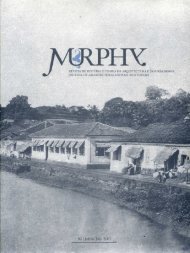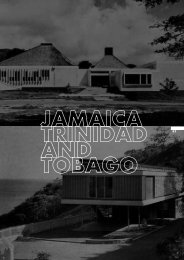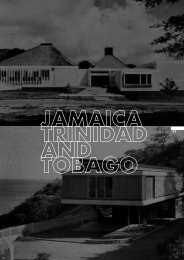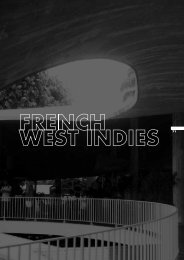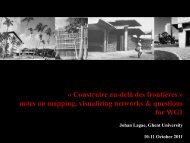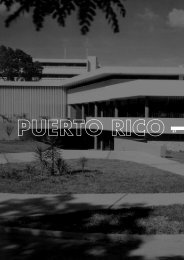Guadeloupe : The Modern Transition
Guadeloupe : The Modern Transition
Guadeloupe : The Modern Transition
Create successful ePaper yourself
Turn your PDF publications into a flip-book with our unique Google optimized e-Paper software.
THE END OF THE 1950s, THE 1960s:<br />
THE INTERNATIONAL STYLE<br />
At the end of the 1950s, the newly created DOM<br />
(overseas departments) initiate a process of assimilation<br />
to France that triggers an important change in<br />
architecture. New players appear on the architectural<br />
scene. Architects Raymond Creveaux and Jacques Tessier<br />
are the main figures that emerge, among other reasons<br />
because they are the main contractors of the very<br />
important operation of urban renewal in Pointe-à-Pitre<br />
(RUPAP). 9 <strong>The</strong> architecture of social housing increases<br />
dramatically and, like the grands ensembles (large social<br />
housing developments) in France, it produces only a<br />
second-rate heritage. But, unlike the mass production of<br />
social housing, projects for state or city facilities produce<br />
some interesting constructions architecturally.<br />
THE INFLUENCE OF LE CORBUSIER’S architecture is<br />
very significant for Creveaux and Tessier, as well as<br />
the ‘contextualized’ approach of architects such as Oscar<br />
Niemeyer. 10 <strong>The</strong>se influences are also noticeable in<br />
the second part of Corbin’s work (fig. 6) and it cannot<br />
be a coincidence if, in 1961, the latter organizes an<br />
important trip to Brazil, for an encounter with Niemeyer’s<br />
Brasilia (fig. 7). 11<br />
Architects from <strong>Guadeloupe</strong>, such as Gérard Corbin and<br />
Gilbert Amarias (a frequent Corbin collaborator), young<br />
architects like Robert Desgranges and Daniel Ricou, and<br />
designers coming from France, such as André Gomis<br />
(1926–1971) or André Bruyère 12 (1912–1998) also<br />
enjoyed their moment of fame during that period (fig. 8).<br />
PRESERVATION AND DEVELOPMENT<br />
In a conference held in 2004 in Pointe-à-Pitre, Jean-Pierre<br />
Giordani spoke about <strong>Guadeloupe</strong>’s heritage as being<br />
“a stock shared by a creation that is old and<br />
contemporary, urban and rural, ‘theoretically’ available<br />
for the free recognition of, and appropriation by, the<br />
inhabitants.” Herein, and in a nutshell, he expresses our<br />
main and crucial issues.<br />
During the 1990s, within the framework of a thematic<br />
campaign, the French Minister of Culture, taking into<br />
account the built heritage of the first half of the twentieth<br />
century, carried out the listing of five works by Ali Tur on<br />
the additional register of historic places. 13 However,<br />
government institutions cannot be the only players of the<br />
protection and development endeavor.<br />
international style––in the Antilles, it remains for local<br />
contemporary architects a set of references that should<br />
nurture their own considerations on the expression and<br />
signification of their work.<br />
If, as August Perret once said, “architecture is what makes<br />
beautiful ruins,” then ensuring its preservation is an<br />
important deed of citizenship.<br />
CHRISTIAN GALPIN is an architect in <strong>Guadeloupe</strong>. He earned his<br />
degree at the School of architecture Paris-La Défense and has been<br />
in practice since 1986. Over the last few years, besides his professional<br />
practice, he has become interested in the architecture between the two<br />
world wars, focusing more particularly on the work of Ali Tur. His work<br />
has led to several publications and lectures in France and abroad.<br />
He has furthermore collaborated to the shooting of a fiction-documentary<br />
(2002) recounting the reconstruction of <strong>Guadeloupe</strong> after 1928.<br />
President of the Regional Council of the Order of Architects of <strong>Guadeloupe</strong><br />
since 2002, he is the former president of the Maison de l’Architecture.<br />
Translated by Isabelle Kite<br />
NOTES<br />
1 Notion evoked by Mia Fuller in her work on the Italian colonial<br />
process.<br />
2 Since the beginning of colonization, construction in this island<br />
subjected to each of nature’s whims and fancies (earth quakes,<br />
cyclones, active volcanoes) was as a rule implemented in wood.<br />
3 Payment in kind settlement. Defeated Germany had to pay its debt<br />
by providing the Allies with products, in particular building materials.<br />
<strong>The</strong> motherland, in all fairness, demanded of <strong>Guadeloupe</strong>, her colony,<br />
that she pay back these supplies.<br />
4 E. Weithas, “De la construction en pays chaud,” L’Architecture<br />
d’Aujourd’hui 3 (March 1936, 7th year).<br />
5 Jean-Pierre Le Dantec, in Architecture en France, concerning<br />
Auguste Perret, talks about a language that is “classic-modern, in<br />
the sense that it unites principles reminiscent of the greco-roman<br />
antiquity to plastic inventions of the first masters (of which he was<br />
himself) of twentieth century architecture.”<br />
6 All of these buildings were designed by Ali Tur.<br />
7 “noue une relation heureuse avec l’existant” in Jean-Pierre<br />
Le Dantec, Architecture en France (Paris: ADPF, ministère des Affaires<br />
étrangères, 1999).<br />
8 Region of Vernou Petit-Bourg on the outskirts of Pointe-à-Pitre,<br />
and region of Saint-Claude the outskirts of Basse-Terre.<br />
9 This very large scale operation of urban renewal for unsanitary<br />
dwellings followed André Malraux’s visit in 1964 (senior French<br />
minister) and the Général De Gaulle’s visit in 1964.<br />
10 On this subject, see Brazil’s pavilion at the 1939 Fair in New York,<br />
which uses brise-soleils and Le Corbusier-like shapes.<br />
11 Architects, building contractors, local and State political figures<br />
take part in this trip.<br />
12 He is the author of the remarkable La Caravelle hotel in<br />
Sainte-Anne (1962).<br />
13 <strong>The</strong> following were listed: the former Governor’s residence<br />
(currently the Préfecture), the Law Courts, the Regional Council palace<br />
in Basse-Terre, the Saint-André de Morne-à-l’Eau church and the former<br />
Pointe-Noire town hall.<br />
85<br />
THE EFFORTS CONCERNING documentation and the<br />
elaboration of tools to communicate with the general<br />
public and to develop this heritage are starting to yield<br />
some results. <strong>The</strong> local communities aware of this<br />
heritage seem to want to implement preservation policies,<br />
and even to restore buildings from that period (fig. 9).<br />
Whatever one may think of the meaning or conditions<br />
of this architecture––colonial or inspired by the<br />
Docomomo N°33<br />
September 2005



